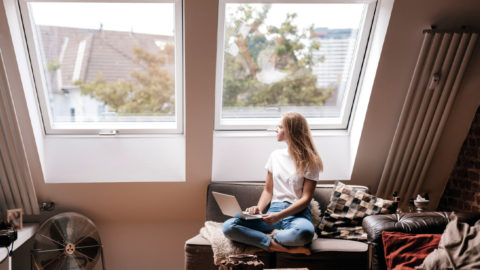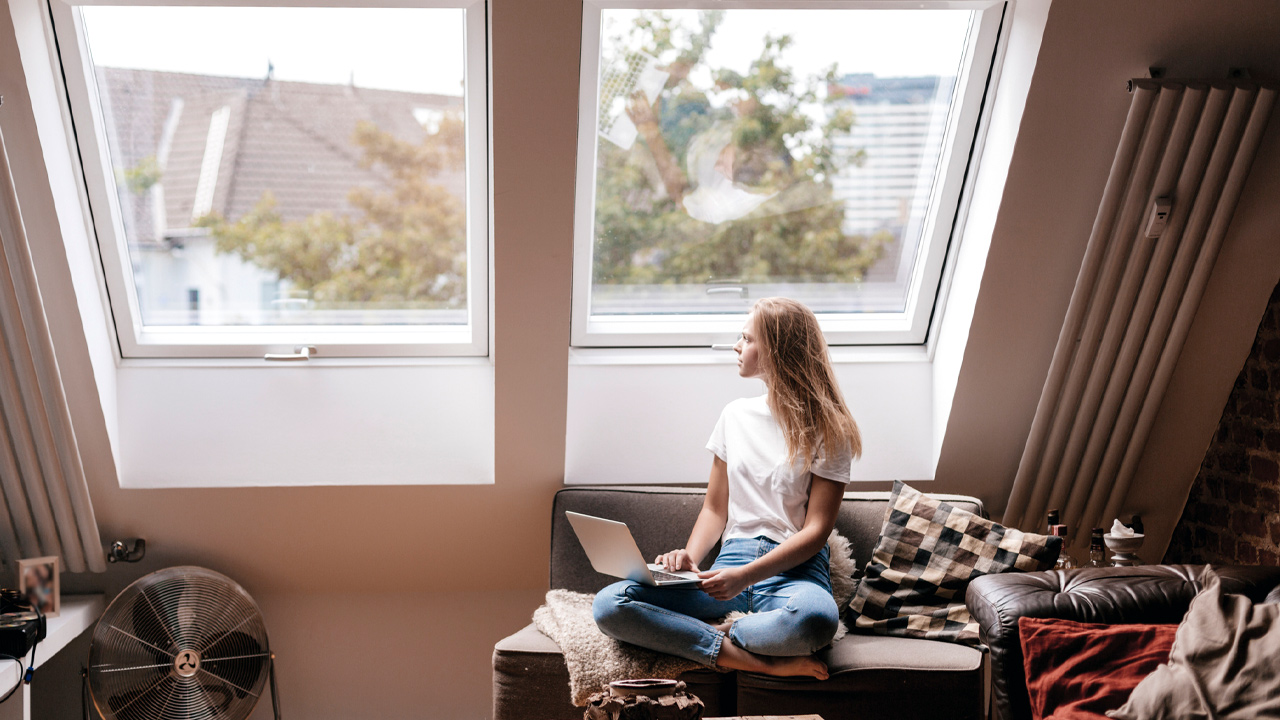Should You Be Wearing Sunscreen Indoors?
We went straight to the pros for answers

The world of beauty myths and misconceptions is vast and wide (we’ve busted a few of the most popular ones in the past), but perhaps no beauty product has more confusion surrounding it than sunscreen. From knowing when to apply it, the best kinds to reach for, how much to use and which ingredients to look out for, there’s certainly no shortage of questions around how exactly to protect our skin from the sun.
And yet, most of us (hopefully) by now understand the importance of wearing sunscreen every day. But does that rule change when we’re indoors every day? Since we’ll all be staying home for a while practicing social distancing, we went straight to the pros to answer some of our most burning questions about when, how and why we should be wearing sunscreen inside our homes.
Below, we’re setting the record straight on wearing sunscreen indoors, once and for all.
So, is a full-spectrum sunscreen (i.e. sunscreen that protects you from both UVA and UVB rays) actually needed indoors?
Assuming you’re living in a place with windows, yes. Even though most windows protect you from UVB rays, “UVA rays penetrate windows,” says Dr. Melissa Levin, dermatologist and founder of Entière Dermatology. “Part of protecting your skin from the damaging rays of ultraviolet radiation is wearing sunscreen daily. It’s a must for skin regardless of the time of the year.”
If you really, truly aren’t near any windows or natural light during the day, you can probably get away with skipping sunscreen or only using a moisturizer with SPF. But may we politely suggest getting yourself near some sunlight, stat, solely for mood-boosting reasons?
Should we only apply sunscreen on our face?
The same cardinal sunscreen rules for when you’re venturing outdoors apply: apply sunscreen to any skin that’s exposed (hands, neck, chest, midriff if you’re living that sports bra-only WFH life).
Why don’t we don’t get sunburns when we’re indoors?
UVB rays are the ones typically associated with burning. They affect the outermost layers of the skin, directly damage DNA and are most commonly the cause of most skin cancers, but the good news is that, as mentioned above, they don’t penetrate windows. However, “UVA [rays play] a large role in pigmentary conditions such as melasma, as well as accelerating photo aging of the skin with brown spots, wrinkles, and fine lines,” says Dr. Levin.
What about High-Energy Visible (HEV) light? Are our phones and computer screens damaging our skin?
Over the last few years, you may have heard about HEV light (the blue light that your phone, tablet and computer screens emit) and its potentially damaging effects on skin. HEV light isn’t only emitted from screens—the sun emits blue light, too. (Fun fact: “the sun’s blue light is a big part of why on a cloudless day we see the sky as blue,” says Dr. Sandy Skotnicki, dermatologist and founder of Toronto’s Bay Dermatology Centre.)
Studies surrounding the long-term effects HEV light are much more limited than they are for heavily researched UVA and UVB rays, but research shows that HEV light from the sun does contribute to skin issues like melasma (those brown patches of discolouration that are caused by everything from hormonal changes to sun damage) and hyperpigmentation. For that reason, researchers have begun to look into blue light from screens, to see if it has a similar effect. And while we know that most sunscreens don’t protect us from HEV light (just UVA and UVB rays), taking precautions like dimming your screens’ brightness levels and using reparative antioxidants like vitamin C in your routine, can help in the fight against HEV light damage.
Determined to take your protection one step further? Brands are beginning to come out with products (like this Chantecaille Blue Light Protection Hyaluronic Serum) that are specifically formulated to shield skin from blue light.
Do we need to reapply sunscreen every hour or two when we’re indoors, like we normally would?
It depends. “The reapplication is really because people put too little on and the sunscreen can lose its stability in the sun,” says Dr. Skotnicki. That being said, sunscreen melts off with sweat, so if you break a sweat during an at-home workout, you’ll need to reapply SPF. If you’re sitting right by a big window all day long, you should reapply every couple hours. And if you’re enjoying midday showers these days, please reapply your sunscreen when you get out.
So while it may be tempting to skip sunscreen these days, in the long run, you’ll be glad that you didn’t. The key to actually remembering to put it on every day, especially now, is to find a sunscreen that you actually enjoy using. (Remember to use an SPF of at least 30, according to Canada’s sun safety regulations.)
Below are some of our favourite sunscreens.
StriVectin Full Screen Broad Spectrum SPF 30 Vanishing Tint, $45, strivectin.com
This just-launched pick is a mineral (or physical) sunscreen, which means it contains titanium dioxide and/or zinc oxide and sits on top of skin, deflecting the sun’s rays (as opposed to chemical sunscreens, which absorb UV rays). It not only goes on clear, but it’s made with French Rice Germ, which helps to protect your skin from some of the potentially damaging effects of blue light.
La Roche-Posay Anthelios Ultra Fluid SPF 50+, $29, laroche-posay.ca
Launching on April 15, the iconic sunscreen formula that’s beloved by dermatologists has a new formula that features the highest UVA protection of any La Roche-Posay product ever.
Beautycounter Countersun Mineral Sunscreen Lotion SPF 30, $49, beautycounter.com
The award-winning physical sunscreen has quickly racked up legions of fans and become a cult favourite.
Sun Bum Moisturizing Sunscreen Lotion SPF 30, $17.99, well.ca
Don’t underestimate the power of scent. If you’re looking for a sunscreen that doubles as a mood-booster, this is it. Featuring an unmistakable summery scent (coconut with a hint of banana), you’ll look forward to applying this sunscreen every morning.




